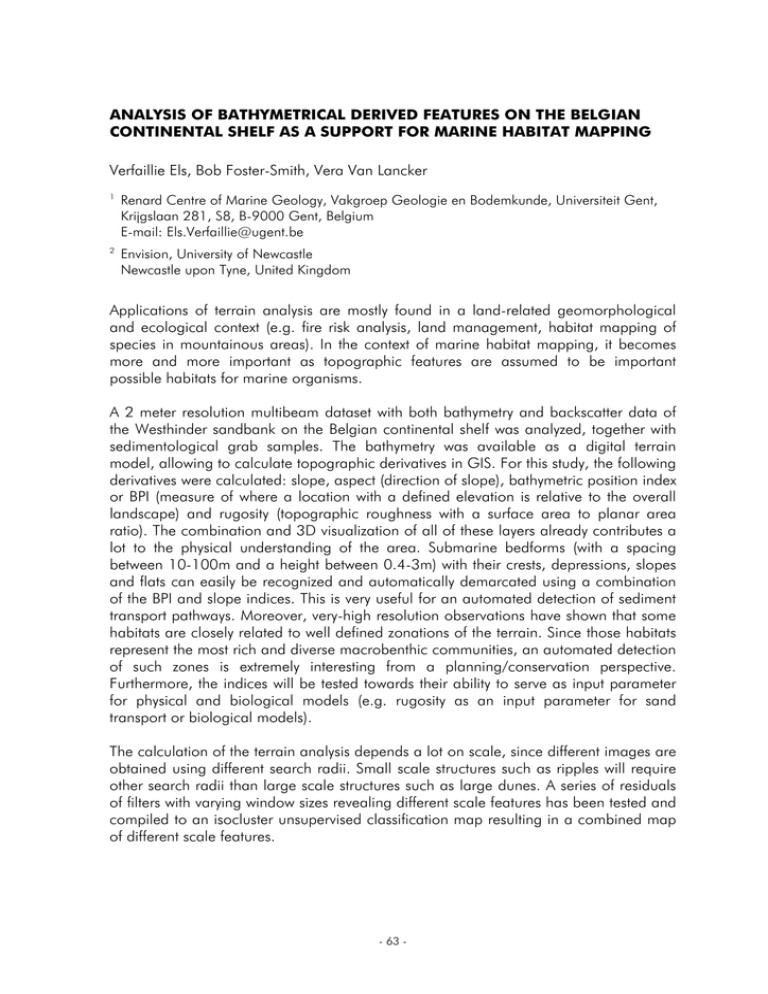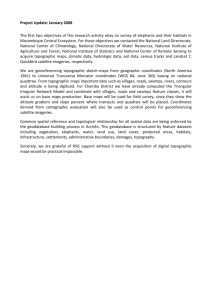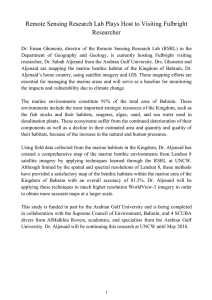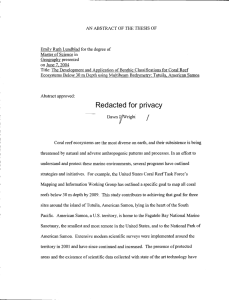ANALYSIS OF BATHYMETRICAL DERIVED FEATURES ON THE BELGIAN
advertisement

ANALYSIS OF BATHYMETRICAL DERIVED FEATURES ON THE BELGIAN CONTINENTAL SHELF AS A SUPPORT FOR MARINE HABITAT MAPPING Verfaillie Els, Bob Foster-Smith, Vera Van Lancker 1 Renard Centre of Marine Geology, Vakgroep Geologie en Bodemkunde, Universiteit Gent, Krijgslaan 281, S8, B-9000 Gent, Belgium E-mail: Els.Verfaillie@ugent.be 2 Envision, University of Newcastle Newcastle upon Tyne, United Kingdom Applications of terrain analysis are mostly found in a land-related geomorphological and ecological context (e.g. fire risk analysis, land management, habitat mapping of species in mountainous areas). In the context of marine habitat mapping, it becomes more and more important as topographic features are assumed to be important possible habitats for marine organisms. A 2 meter resolution multibeam dataset with both bathymetry and backscatter data of the Westhinder sandbank on the Belgian continental shelf was analyzed, together with sedimentological grab samples. The bathymetry was available as a digital terrain model, allowing to calculate topographic derivatives in GIS. For this study, the following derivatives were calculated: slope, aspect (direction of slope), bathymetric position index or BPI (measure of where a location with a defined elevation is relative to the overall landscape) and rugosity (topographic roughness with a surface area to planar area ratio). The combination and 3D visualization of all of these layers already contributes a lot to the physical understanding of the area. Submarine bedforms (with a spacing between 10-100m and a height between 0.4-3m) with their crests, depressions, slopes and flats can easily be recognized and automatically demarcated using a combination of the BPI and slope indices. This is very useful for an automated detection of sediment transport pathways. Moreover, very-high resolution observations have shown that some habitats are closely related to well defined zonations of the terrain. Since those habitats represent the most rich and diverse macrobenthic communities, an automated detection of such zones is extremely interesting from a planning/conservation perspective. Furthermore, the indices will be tested towards their ability to serve as input parameter for physical and biological models (e.g. rugosity as an input parameter for sand transport or biological models). The calculation of the terrain analysis depends a lot on scale, since different images are obtained using different search radii. Small scale structures such as ripples will require other search radii than large scale structures such as large dunes. A series of residuals of filters with varying window sizes revealing different scale features has been tested and compiled to an isocluster unsupervised classification map resulting in a combined map of different scale features. - 63 -








